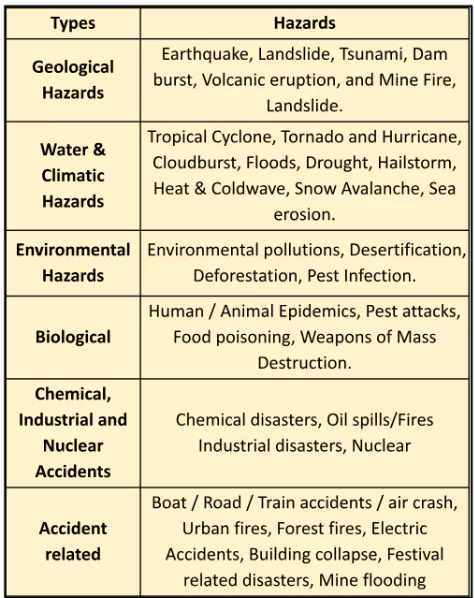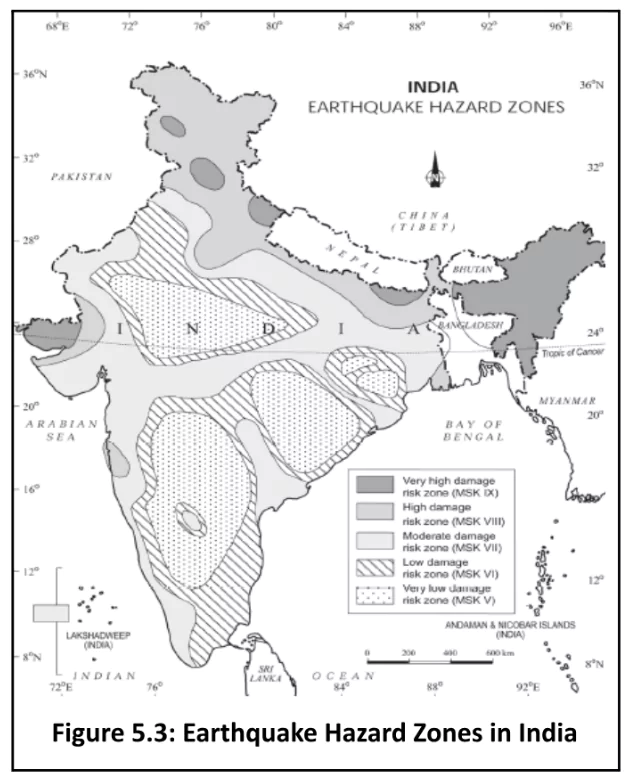Disasters, like earthquakes and tsunamis, disrupt communities, causing extensive damage beyond their ability to cope. They result from hazards, vulnerabilities, and limited capacity to manage risks. Understanding these terms is crucial to prepare for and respond to such events.
Natural Hazards and Disasters: Disaster, Hazard, Vulnerability, and Risk

- Disaster: It can be defined as “A serious disruption in the functioning of the community or a society causing widespread material, economic, social or environmental losses which exceed the ability of the affected society to cope using its own resources”.
- It is a result of the combination of hazard, vulnerability and insufficient capacity to reduce the potential chances of risk.
- Hazard: It may be defined as “a dangerous condition or event that threatens or has the potential for causing injury to life or damage to property or the environment’’.
- Vulnerability: It may be defined as “the extent to which a community, structure, services or geographic area is likely to be damaged or disrupted by the impact of a particular hazard, on account of their nature, construction and proximity to hazardous terrains or disaster-prone area”. Vulnerabilities can be categorized into:
- Physical Vulnerability: It includes notions of who and what may be damaged or destroyed by natural hazards.
- It is based on the physical condition of people and elements at risk, such as buildings, infrastructure etc.
- Socio-economic Vulnerability refers to the degree to which individuals and communities are susceptible to harm from disasters due to their social and economic status.
- Risk is a measure of the expected losses due to a hazard event occurring in a given area over a specific time period.
Enroll now for UPSC Online Course
Understanding Earthquakes and Tsunamis: Causes, Measurement, and Impact
A. Earthquakes
- Definition: Earthquake refers to the sudden shaking of the earth’s crust.
- Causes of Earthquakes
- Earthquakes due to Plate Tectonics
- Earthquakes due to other causes: volcanic eruption, rock falls, landslides, subsidence, particularly in the mining areas, impounding of dams and reservoirs, etc.
- Measuring Earthquakes: Earthquakes can be measured by the use of two distinctively different scales of measurement:
- Richter Scale: Measures the magnitude (strength/elastic energy released by earthquake) of the earthquake.
- It is a logarithmic scale—an increase of 1 in magnitude corresponds to a 10-fold increase in the amplitude of shaking.
- It is expressed numerically, ranging from 0 to 10.
- Mercalli Scale: Measures the intensity (effects) of an earthquake where it occurs; scale spans from 1 to 12
 Intensity indicates the violence of shaking or the extent (or potential) of damage at a given location due to a particular earthquake.
Intensity indicates the violence of shaking or the extent (or potential) of damage at a given location due to a particular earthquake. - The most commonly used intensity scales are: Modified Mercalli (MM) Intensity Scale and Medvedev-Sponhener-Karnik (MSK) Intensity Scale.
- Modified Mercalli Scale: Enhanced and more detailed version of the original Mercalli Intensity Scale, providing a better description of the effects of an earthquake at a specific location.
- The five seismic zones I, II, III, IV and V in the Indian seismic code (IS:1893-1984) correspond to areas that have potential for shaking intensity on the MMI scale of V or less, VI, VII, VIII, and IX or more, respectively.
Distribution Pattern of Earthquakes in India
- Seismic Zoning Map of India: It is divided into the following five earthquake zones:
- Very high damage risk zone;
- High damage risk zone;
- Moderate damage risk zone;
- Low damage risk zone;
- Very low damage risk zone.
- Very High Damage Risk Zone: North-east states, areas to the north of Darbhanga and Araria along the Indo-Nepal border in Bihar, Uttarakhand, Western Himachal Pradesh (around Dharamshala) and Kashmir Valley in the Himalayan region and the Kachchh (Gujarat).
- High Damage Risk Zone: Parts of Jammu and Kashmir, Ladakh, Himachal Pradesh, Northern parts of Punjab, Eastern parts of Haryana, Delhi, Western Uttar Pradesh, and Northern Bihar.
- Remaining Parts of the Country: fall under moderate to very Low Damage Risk Zone.
- Deccan Plateau: Most of the areas of the Deccan plateau are considered safe as far as earthquakes are concerned.
Tsunami
- Definition: Tsunami refers to a series of large waves on ocean surfaces caused by a sudden displacement of water. These are also called shallow water waves.
- Causes of a Tsunami:
- The geological movements that cause tsunamis are produced in three major ways:
- Fault Movements: on the seafloor, accompanied by an earthquake that causes tsunamis.
- Landslides: either occurring underwater or originating above the sea.
- Volcanic Activity: near the shore or underwater.
- Example: Krakatoa eruption (1883) in Indonesia, produced a tsunami in Java and Sumatra.
- General Characteristics of Tsunami:
- Speed of Waves: in the ocean depends upon the depth of the water.
- It is more in the shallow water than in deep oceans because, as a tsunami enters shallow water near land, it slows down, wavelengths decrease, waves grow in height, and currents intensify.
- Impact: It is less over the ocean and more near the coast.
- Examples: Tsunamis are frequently observed along the Pacific Ring of Fire, particularly along the coast of Alaska, Japan, the Philippines and other islands of Southeast Asia, Indonesia, Malaysia, Myanmar, Sri Lanka, and India.
Enroll now for UPSC Online Classes
- India has volunteered to join the International Tsunami Warning System after the 2004 tsunami disaster.
|
Conclusion
Earthquakes, sudden shifts in the earth’s crust, and tsunamis, large ocean waves, pose significant threats. India, particularly prone to earthquakes and tsunamis, has measures in place, like seismic zoning and joining the International Tsunami Warning System, to mitigate risks and enhance preparedness.
![]() June 24, 2024
June 24, 2024
![]() 1628
1628
![]() 0
0

 Intensity indicates the violence of shaking or the extent (or potential) of damage at a given location due to a particular earthquake.
Intensity indicates the violence of shaking or the extent (or potential) of damage at a given location due to a particular earthquake.